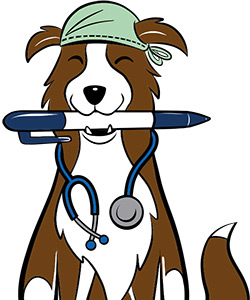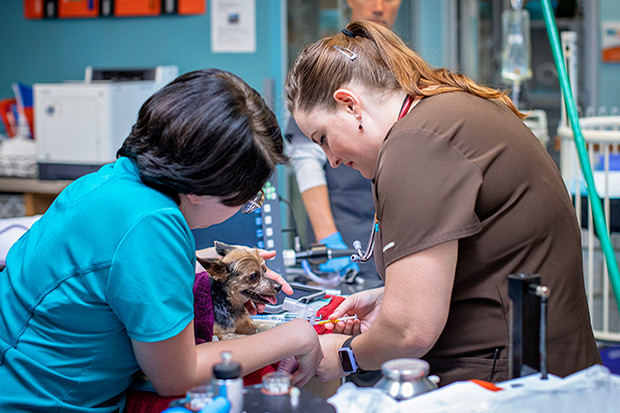AAHA releases veterinary technician utilization guidelines
When asked what their biggest struggles are, veterinary practice leaders list recruitment and retention of talented team members at the top of the list every time, according to Dr. Jessica Vogelsang, chief medical officer at the American Animal Hospital Association (AAHA).
Meanwhile, credentialed veterinary technicians (CVT) cite lack of full utilization of their skills as a top reason for leaving the profession, along with burnout, low pay, and decreased job satisfaction, according to AAHA.
Proper utilization of veterinary technicians has been shown to help teams run more efficiently, which in turn increases access to veterinary services, improves patient care, and addresses retention problems.
Yet, many veterinary teams remain oblivious to their own utilization issues, mostly because of unfamiliarity with licensure and the scope of practice of veterinary technicians.
That is why AAHA developed the 2023 AAHA Technician Utilization Guidelines, to provide a picture of what proper utilization looks like and what the benefits are to the individual credentialed technician, veterinary team, and the future of veterinary medical care.
These guidelines, launched October 3, provide team member utilization assessment tools, an outline showing levels of veterinary technician utilization and examples of specific skill sets, and case examples showing optimal utilization.
“We made a decision to focus specifically on the optimal utilization of credentialed veterinary technicians and provide a framework that practices can follow to open up the conversation and come up with a personalized plan that applies in a variety of circumstances,” Dr. Vogelsang said.
Benefits of optimal technician utilization
Several members of the National Association of Veterinary Technicians in America (NAVTA) served on the task force that developed the guidelines, including co-chairs Natalie Boursiquot, a CVT and specialty area manager for Southern Veterinary Partners, and Heather Prendergast, a registered veterinary technician and CEO of Synergie Consulting.
Jamie Rauscher, a licensed veterinary technician and NAVTA president, also was a task force member. She said that poor utilization of credentialed veterinary technicians’ skills is a common occurrence in the profession.
“We are continually working on educating veterinarians on how to effectively utilize their technicians to allow both for job satisfaction for the technicians as well as growth of the practice both medically and financially,” Rauscher said. “We are hoping AAHA's release of the guidelines will help to contribute to our focus on technician utilization and bring a broader awareness to the issue.”
A survey of credentialed veterinary technicians demonstrated that these veterinary professionals measure their intrinsic and extrinsic rewards by both their pay and the value and meaning of the specific tasks they perform. Optimal utilization correlates with higher job satisfaction and self-identity.
Further, leveraging credentialed veterinary technicians to the full extent of their education and training contributes to financial sustainability. Practices where veterinarians rarely perform tasks that credentialed veterinary technicians can, and should do, show an average revenue increase of 36%.
Setting practices up for success
To start integrating veterinary technicians more into the clinic workflow, the guidelines recommend practice leaders create a utilization team with representation from all practice roles. The team can then perform a gap analysis by evaluating the team’s daily duties and tasks and identifying which tasks are routinely performed by veterinarians that could be performed by credentialed veterinary technicians, as well as future growth opportunities if tasks are not a current duty.
Part of the analysis also requires reviewing the state veterinary practice act, rules, and regulations for a scope of duties that can be delegated to credentialed veterinary technicians and other team members.
Dr. Vogelsang explained that there is no real consistency from state to state for veterinary technicians, which compounds the issues. Although some states list the tasks that credentialed veterinary technicians can perform, they may not actually limit those tasks only to CVTs. Other states do not define the scope of practice beyond restricting the act of surgery, diagnosis, prescription, and prognosis to licensed veterinarians.
“Amid this confusion, many veterinary teams err on the side of extreme caution,” according to the guidelines.
To address this, Dr. Vogelsang said the Veterinary Team Member Utilization Assessment Tool “will allow teams to build out very exacting roles and responsibilities and remove the ambiguity that so often clouds this discussion.”
She added, “It's one of the central themes of the guideline that in order for teams to really fully utilize their teams, they need to put in a good amount of intentional effort to understand the specific skills and regulations that apply to them since there is such tremendous variability.”
Areas the guidelines suggest exploring first for greater leveraging of CVTs are appointments and initial assessments, surgeries and anesthetic procedures, and telehealth and teletriage.
Another action suggested was the addition of a mentorship program with collaborative learning for both new graduate veterinarians and CVTs—either resourced externally or built within the practice.
Dr. Vogelsang explained that she has already heard of practices planning a team meeting around reviewing the guidelines to implement the plans and tools in their place of work.
“I think probably the most interesting revelation to me was the recurring theme of trust needing to happen in order for optimal utilization to thrive. And while the guideline can’t solve that, I think it does a solid job of directing folks to the right conversations that need to happen,” she said.
A version of this story appears in the January 2024 print issue of JAVMA
AVMA resources available on leveraging veterinary technicians
The AVMA has long been committed to supporting veterinary technicians, veterinary technologists and veterinary technician specialists and encouraging veterinarians to fully leverage these important team members. The AVMA believes doing so improves productivity and staff satisfaction by enhancing how their skills are employed, particularly in situations when veterinary practices are experiencing operational capacity challenges.
More recently, the AVMA created the Committee on Advancing Veterinary Technicians and Technologists (CAVTT) earlier this year. This committee is charged with creating resources to ensure that veterinary technicians can fully utilize their education and skills in all types of veterinary practices, and to support and advance the veterinary technology profession generally.
The AVMA has funded a Task Force and Working Group on Veterinary Technician Utilization over the past three years. Recommendations produced by the task force serve as the basis for ongoing research directed by the working group to identify the barriers to appropriate participation and the development of evidence-based solutions.
The AVMA has also published many articles promoting the economic benefits of appropriate collaboration among team members, and is currently collaborating with the National Association of Veterinary Technicians in America (NAVTA) to develop resources and tools for veterinarians and veterinary technicians to identify obstacles and provide pathways to support effective collaboration within the practice.
Finally, the AVMA has developed an on-demand continuing education course titled, "How well do you utilize veterinary technicians," designed to help veterinarians discover how to fully leverage veterinary technicians and their many skills, and explore how their practices measure up against other practices and current standards.
The AVMA has further information on empowering veterinary technicians to support practice success on its website.
Related content
Veterinary technicians being paid more but still face concerns about wages, burnout, debt
Task force recommends solutions for technician utilization
Survey finds underuse related to retention for veterinary technicians
Prime issue for veterinary technicians: Underutilization
Veterinary technicians being paid more but still face concerns about wages, burnout, debt
Practice inefficiencies compound veterinary stress



